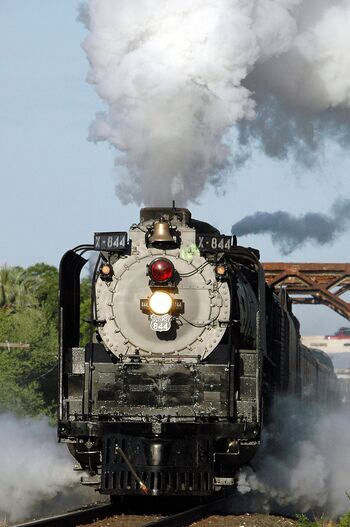Train (transport): Difference between revisions
imported>John Stephenson (stub) |
imported>Henry A. Padleckas (mentioned locomotive and railroad or train cars and their wheels rolling on track, and couplers) |
||
| Line 2: | Line 2: | ||
{{dambigbox|the form of transport|Train}} | {{dambigbox|the form of transport|Train}} | ||
{{Image|Steam locomotive.jpg|right|350px|A [[steam locomotive]] of the [[Union Pacific Railroad]], [[United States of America|USA]].}} | {{Image|Steam locomotive.jpg|right|350px|A [[steam locomotive]] of the [[Union Pacific Railroad]], [[United States of America|USA]].}} | ||
A '''train''' comprises one or more vehicles connected together and running on a track, usually for passenger travel or freight transport. Trains typically run on two rails, but [[monorail]] services require only one, and [[maglev]] trains do away with track altogether. Early trains were [[steam locomotive]]s, but today most trains are headed by [[diesel]] locomotives or are supplied with [[electricity]] from overhead wires or other rails. | A '''train''' comprises one or more vehicles connected together and running on a [[Train track|track]], usually for passenger travel or freight transport. The unit or vehicle powering the movement of the train is called the '''[[locomotive]]''' or sometimes ''engine''. The usually unpowered vehicle units pulled by the locomotive are called '''[[railroad cars]]''' or '''[[train cars]]'''. Each of these units typically has a [[coupler]] at both the front and back for connecting to other such units. Trains typically run on two rails, but [[monorail]] services require only one, and [[maglev]] trains do away with track altogether. Trains most commonly run on wheels on each of the units which roll on the track or railroad. Early trains were powered by [[steam locomotive]]s, but today most trains are headed by [[diesel]] locomotives or are supplied with [[electricity]] from overhead wires or other rails. | ||
Revision as of 06:10, 24 February 2011
A train comprises one or more vehicles connected together and running on a track, usually for passenger travel or freight transport. The unit or vehicle powering the movement of the train is called the locomotive or sometimes engine. The usually unpowered vehicle units pulled by the locomotive are called railroad cars or train cars. Each of these units typically has a coupler at both the front and back for connecting to other such units. Trains typically run on two rails, but monorail services require only one, and maglev trains do away with track altogether. Trains most commonly run on wheels on each of the units which roll on the track or railroad. Early trains were powered by steam locomotives, but today most trains are headed by diesel locomotives or are supplied with electricity from overhead wires or other rails.
